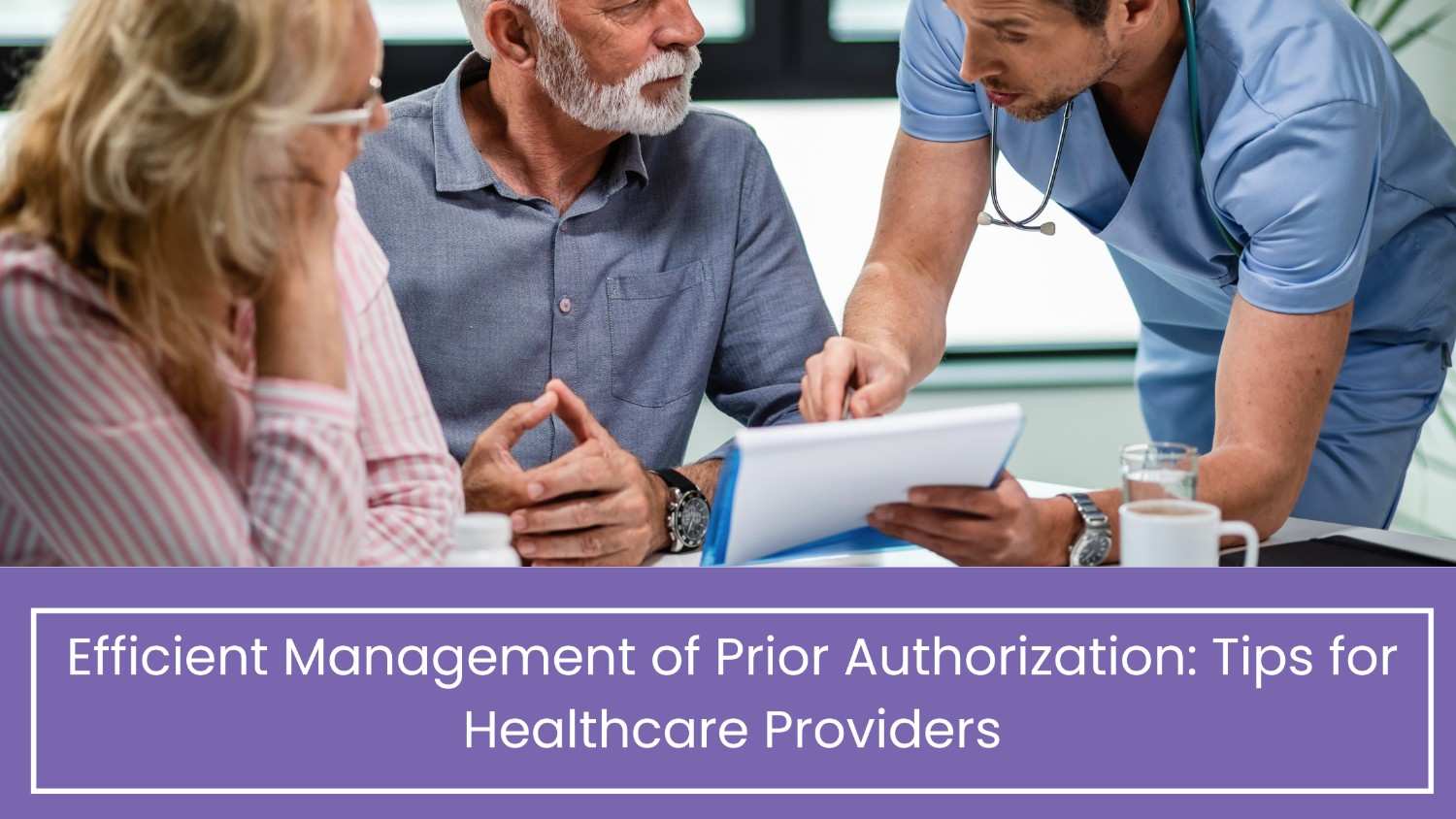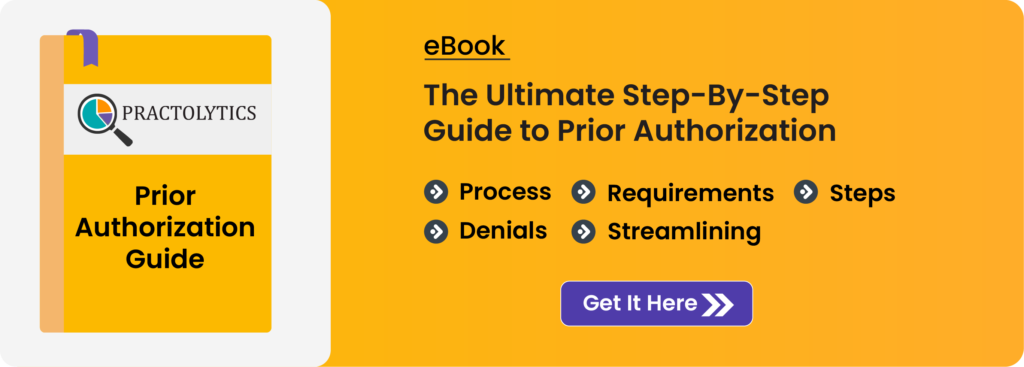Efficient Management of Prior Authorization: Tips for Healthcare Providers
Prior Authorization or Pre-approval (PA) is a routine step used by healthcare funders to gauge coverage for recommended services, treatments, or drugs. Despite its aim of ensuring economical and necessary care, the prior authorization process often draws ire for its hefty administrative load, causing setbacks in patient care and escalating workloads for healthcare providers. It’s crucial to refine this process strategically to boost productivity, reduce costs, and improve patient outcomes. This article will explore effective methods and resources that healthcare providers can use to manage the pre-approval process smoothly.
Table of Contents
Understanding the Challenges of Prior Authorization
Before getting Prior Authorization, there are various steps involved, such as providing detailed clinical data, waiting for payer assessment, and sometimes contesting rejections. This process is time-consuming and annoying for both medical personnel and patients. Key issues include excessive paperwork, treatment delays, inconsistent rules, and challenging rejections. To tackle these issues, it’s essential to implement efficient methods and resources for smoother prior approval processes.
Strategies for Streamlining Prior Authorization
1. Enhancing Operational Efficiency
To optimize procedural efficiency, it is essential to implement strategic approaches:
- SOP Crafting: Develop detailed Standard Operating Procedures (SOPs) that clearly outline each phase from initiation to approval. Staff members should adhere to these guidelines rigorously after completing comprehensive training. This ensures that everyone is well-versed in the procedures and maintains consistency across all operations.
- Process Management Hub: Establish a dedicated team or department to handle all process-related inquiries. This focused approach helps cultivate expertise, reduces errors, and enhances productivity efficiently and transparently.
2. Leveraging Technological Innovations
Harnessing advanced technological solutions can significantly alleviate the administrative burden associated with prior authorization (PA) processes. Essential tools encompass:
- Integration of Electronic Health Records (EHR): Synchronizing prior authorization (PA)processes with EHR systems for automated data entry and submission, mitigating manual errors and expediting processing times.
- Utilization of Automated PA Systems: Deploying automated prior authorization (PA) tools capable of swiftly determining PA necessity and electronically submitting requests, often equipped with pre-established templates and tailored requirements to streamline submissions.
- Implementation of Real-time Benefit Verification (RTBV): Incorporating RTBV tools furnishing instantaneous insights into a patient’s insurance coverage and prior authorization (PA)prerequisites at the point of care, empowering providers to address PA requirements seamlessly during patient consultations, thereby reducing potential delays.
3. Improving Interaction and Cooperation
Efficient interaction and cooperation among healthcare professionals, insurers, and individuals are crucial for a smooth prior authorization (PA) procedure.
- Assign Coordinators: Allocate specific team members or organizers to handle communications with insurers. This helps maintain uniformity and streamline the management of prior authorization (PA) requests and appeals.
- Employ Secure Messaging Channels: Use secure communication channels for interactions with insurers and individuals. This ensures the safe and effective exchange of sensitive data.
- Educate Individuals: Provide individuals with details about the prior authorization (PA) procedure, potential setbacks, and their responsibility in expediting approvals. Engaged and informed individuals can significantly aid in accelerating the process by promptly furnishing necessary details.
4. Continuous Monitoring and Enhancement
Frequently reviewing and assessing the progression of prior authorization (PA) procedures aids in recognizing areas for enhancement and assures continual effectiveness.
- Track Vital Performance Indicators (VPIs): Keep an eye on VPIs such as the duration for PA acquisition, endorsement rates, and denial occurrences. Utilize this information to pinpoint obstacles and zones necessitating enhancement.
- Gather Input: Routinely acquire input from personnel and clients concerning their encounters with the prior authorization (PA) procedure. Utilize this input to implement essential modifications and enhancements.
- Conduct Routine Instruction: Administer consistent instruction for personnel regarding the most recent prior authorization (PA) prerequisites, utilities, and optimal methodologies. Sustaining informed and proficient personnel is imperative for upholding an effective PA procedure.
Tools for Efficient Prior Authorization Management
1. Electronic Permission Prioritization (EPP)
platforms enhance the prior authorization (PA) procedure by automating the submission and monitoring of permission requests. These systems seamlessly merge with Electronic Health Record (EHR) frameworks, empowering medical professionals to submit requests directly from patient records. Notable attributes of EPP platforms encompass:
- Automated Processing: Generate and send prior authorization (PA) inquiries using clinical data from the EHR. Keep an eye on PA requests as they progress, cutting down on follow-up communication.
- Custom Templates: Use payer-tailored forms to prevent denials due to missing or wrong info.
2. Clinical Decision Support Systems (CDSS)
Medical software tool guides healthcare professionals, helping them decide on patient treatments. These tools assist in the prior authorization process by notifying providers about necessary authorizations for prescribed treatments or medications, suggesting other options to bypass authorization requirements, and ensuring all required clinical details are included in authorization requests to increase approval chances.
3. Payer Portals and APIs
Various entities in the healthcare sector offer digital platforms and interfaces for managing prior authorization (PA) requests. These tools enable users to interact with payer systems directly, facilitating efficient communication. They allow for direct submission of prior authorization (PA) requests, provide instant status updates, and simplify the process of uploading required documents and clinical data.
4. Tools for Workflow Automation
Tools for workflow automation enhance administrative processes by handling repetitive tasks automatically. When applied to Prior Authorization (PA), these tools can:
- Automate Data Entry: Pull data from clinical records and populate PA forms, minimizing manual mistakes and saving time.
- Schedule Follow-ups: Set up automatic follow-up tasks and reminders for incomplete PA requests, ensuring timely responses.
- Generate Reports: Produce comprehensive reports on prior authorization (PA) activities, aiding providers in tracking performance and spotting areas for enhancement.
Case Studies: Successful PA Streamlining
Case Study 1: Local Health Center
A local health center encountered long waits for securing prior authorizations (PA) for patient medications. This caused disruptions in patient care and added stress to the staff. To solve these problems, the center introduced an electronic PA (ePA) system linked with an electronic health records (EHR) system. The outcomes were immediate:
- Faster Processing: The average time to get prior authorization (PA) was cut from five days to just one day.
- Higher Approval Rates: The approval rate for prior authorization (PA) requests went up by 20% since submissions were completer and more accurate.
- Better Patient Experience: Patients faced fewer delays in receiving their medications, which led to higher satisfaction.
Case Study 2: Major Hospital Network
For example, a major hospital network faced issues with varied prior authorization (PA) processes across its different units. To unify and optimize PA management, the network employed the following measures:
- Centralized PA Unit: Created a centralized unit responsible for all prior authorization (PA) requests, enhancing consistency and expertise.
- CDSS Implementation: Linked a Clinical Decision Support System (CDSS) to the hospital’s Electronic Health Record (EHR) to notify providers of prior authorization (PA) requirements and recommend alternative treatments.
- Ongoing Training: Held regular training sessions for staff on prior authorization (PA) best practices and payer guidelines.
The results were as follows:
- Improved Efficiency: Centralizing operations lessened the workload on various departments, enabling them to prioritize patient care.
- Quicker Approvals: Utilizing CDSS enabled providers to select treatments that bypassed prior authorization or made sure requests were fully prepared, leading to quicker approvals.
- Fewer Denials: Ongoing training ensured staff were well-informed about prior authorization criteria, which resulted in fewer denials and a
Case Study 3: Specialized Pharmacy
For example, a pharmacy dealing with complex medications encountered difficulties in handling prior authorization (PA) requests due to differing payer requirements. To improve their processes, the pharmacy employed several solutions:
- Automated PA System: Adopted an automated prior authorization (PA) system that merged with their pharmacy management software, enabling swift and precise submissions.
- RTBV Tools: Made use of tools to verify patient insurance coverage and PA needs at the point of prescription.
- Payer Portals: Used payer portals to directly submit and monitor prior authorization (PA) requests with insurance firms.
The impact was significant:
- Improved Accuracy: The automated system reduced errors in prior authorization (PA) submissions, leading to higher approval rates.
- Timely Approvals: Real-time benefit verification and direct access to payer portals resulted in faster PA approvals.
- Operational Efficiency: Streamlined prior authorization (PA) processes allowed pharmacy staff to focus on patient care and support, rather than administrative tasks.
The effects were notable:
- Increased Precision: The use of automation minimized mistakes in prior authorization submissions, enhancing approval rates.
- Faster Approvals: Immediate benefit checks and direct connectivity to payer systems led to quicker prior authorization approvals.
- Enhanced Efficiency: More efficient prior authorization of patient-centered pharmacy personnel to prioritize patient care over administrative duties.
Future Trends in Prior Authorization
The way prior authorization works is always changing, and several trends are set to make the process smoother:
New Technologies
Emerging technologies like advanced algorithms and smart systems could transform PA processes by:
- Predicting Needs: Looking at patient information to foresee which treatments will need approval, letting providers address these needs in advance.
- Automating Reviews: Employing smart systems to automate the review and approval of PA requests based on set criteria and insurance policies.
- Increasing Accuracy: Boosting the accuracy of prior authorization (PA) submissions by studying past rejections and approvals to find common mistakes and improve submissions.
Blockchain Tech
Blockchain tech provides a safe and clear method to handle prior authorization (PA) information, with potential uses such as:
- Data Sharing: Allowing secure and clear sharing of patient info between providers and insurers, cutting down on redundant submissions.
- Audit Records: Creating unchangeable audit records of PA requests and decisions, boosting accountability and transparency.
- Faster Approvals: Enabling quicker prior authorization (PA) approvals by automating and confirming the authenticity of clinical details and paperwork.
Modifications in Policies and Backing by Regulations
Ongoing adjustments in policies and regulatory backing aim to lessen the administrative load of prior authorization (PA):
- Initiatives for Standardization: Efforts to make prior authorization (PA) requirements and processes uniform across different payers can simplify matters for providers.
- Legislative Backing: Legislative measures that encourage the use of electronic prior authorization (ePA) and eliminate unnecessary prior authorization (PA) steps can further ease the process.
- Stakeholder Cooperation: Enhanced cooperation between providers, payers, and regulatory bodies can result in more efficient and patient-focused PA procedures.
Streamlining prior authorization is essential for improving the efficiency of healthcare delivery, reducing administrative burdens, and enhancing patient care. By standardizing processes, leveraging technology, enhancing communication, and continuously monitoring and improving practices, healthcare providers can effectively manage PA processes. The adoption of innovative tools such as Epa platforms, CDSS, payer portals, and workflow automation tools can further enhance efficiency and reduce delays. As the healthcare landscape continues to evolve, embracing future trends such as AI, blockchain, and supportive policy changes will be crucial in achieving a streamlined and efficient prior authorization (PA) process.
By implementing these best practices and staying abreast of emerging trends, healthcare providers can ensure that their prior authorization (PA) processes are efficient, accurate, and patient-centered, ultimately leading to better health outcomes and a more sustainable healthcare system.
At Practolytics, we’re dedicated to supporting healthcare professionals with implementing best practices and staying updated on current trends in the field. By ensuring that processes related to prior authorization (PA) are streamlined and focused on patients, we contribute to positive health results and a more stable healthcare system. Our focus on advanced solutions in healthcare sets us apart as a trusted ally in managing the complexities of prior authorization, enabling providers to concentrate on patient well-being rather than administrative duties.
ALSO READ – What Makes Outsourcing the Best Method for Prior Authorizations?
Talk to Medical Billing Expert Today — Get a Free Demo Now!






